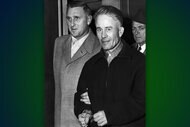Create a free profile to get unlimited access to exclusive videos, breaking news, sweepstakes, and more!
Is 'The Texas Chainsaw Massacre' Based On A True Story?
Tobe Hooper's 1974 masterpiece "The Texas Chainsaw Massacre" claims to be based on a true story. How much is the film similar to the real life crimes of killer Ed Gein, by which Hooper was inspired?

When "The Texas Chainsaw Massacre" was released in 1974, it was banned throughout the country over its severe depictions of violence. In the years that followed, the brutal slasher would be hailed as a cinematic masterpiece and has since been cited as the inspiration for countless horror films. But how similar is director Tobe Hooper's hideous magnum opus to the crimes on which they claim to be based?
"The Texas Chainsaw Massacre," introduces its audience to Leatherface, a monstrous and unnamed giant whose house is filled with vile trophies taken from his victims. Through exposition, we learn that Leatherface is a member of a disgraced butcher family who have resorted to cannibalism following the dissolution of their business.
Throughout the movie, Leatherface stalks a gang of nubile youths as they attempt to escape his family's grotesque abode. A classic Final Girl manages to flee.
Hooper's film claims to be based on a true story, an assertion which fact-checking website Snopes has declared as only "sort of" true. Text on the packaging of VHS copies of the film introduced the movie as a factual account of events: "The film is an account of a tragedy which befell a group of five youths, in particular Sally Hardesty. For them an idyllic summer afternoon drive became a nightmare when they were exposed to an insane and macabre family of chain saw killers. One by one they disappear to be brutally butchered, each murder more horrendous than the last with one victim being hung live on a meat hook, another trapped in his wheelchair as he is hacked to death and the surviving member of the group making a frantic bid for escape in the horrific climax ... This video cassette is based on a true incident and is definitely not for the squeamish or the nervous."
It's clear that Hooper took several artistic liberties with the source material, stretching the boundaries of fiction so as to problematize the violence of the media itself — Hooper has since admitted that his bloody cinematic experience was inspired by the sanguine civil unrest of the decade in which the movie was created and that the bulk of the story was spun off from reports of the murders of Ed Gein.
Apprehended in November 1957, Ed Gein was ultimately found guilty but legally insane for the killing of Bernice Worden, a local hardware store owner, according to History.com. It was what police found inside Gein's home that would garner infamy for the murderer.
When law enforcement officials searched Gein's home they discovered Worden's body hung upside down and gutted in a shed on the property. Gein's living space was found to have several human body parts transformed into furniture and fashion accessories including lamps, masks, corsets, leggings, and belts made out of human flesh and bones. Gein later admitted to making several nocturnal raids of local cemeteries to procure materials for his illicit hobbies.
In "Texas Chainsaw," the home of Leatherface is populated with similarly macabre artifacts — although the manner by which the monstrous family obtained their repulsive paraphenalia is never totally explained.
Gein later explained his delusional beliefs that led to his crimes: he was hoping to create a human-skin suit made from women so as to become his mother, who in childhood had lectured her children about her own moral and spiritual purity. And although this facet of Gein's crimes did not find its way into "Texas Chainsaw," it did serve as inspiration for the movie "Psycho" by Alfred Hitchcock and for the Buffalo Bill character in "The Silence of the Lambs," based on a book by Thomas Harris.
Other similarities between Gein and Leatherface are largely coincidental. A Q+A with actor Gunnar Hansen, who played Leatherface in the film, shows what parts of the crime Hooper considered in the creation of the movie.
"[Hooper] had heard of Ed Gein, the man in Plainfield, Wisconsin, who was arrested in the late 1950s for killing his neighbor and on whom the movie Psycho was based. So when they set out to write this movie, they decided to have a family of killers who had some of the characteristics of Gein: the skin masks, the furniture made from bones, the possibility of cannibalism. But that’s all. The story itself is entirely made up. So, sorry folks. There never was a massacre in Texas on which this was based. No chainsaw either," said Hansen.
Gein ultimately passed away from lung cancer on July 26, 1984, at the age of 77. His tombstone was vandalized and eventually completely stolen — but his crimes live on, haunting the celluloid of innumerable horror films.
This week John Thrasher and Daryn Carp from Oxygen's Martinis & Murder podcast covered the notrious murderer Ed Gein on their show.
[Photo: Ian Forsyth / Getty Images]

















